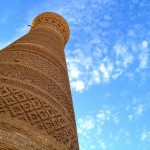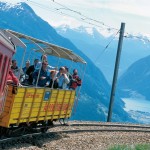Janette Griffiths goes Time Travelling In Samarkand and Discovers That The Ancient And Modern Can Happily Co-Exist.
My phone is quite sure that I am going to summer camp in Central Asia. No matter how often I type in Samarkand, a name forever associated with camel caravans, the endless, lonely steppes and sun setting over blue-domed mosques, 21st century technology responds “summer camp” and wants to send me off to sleep in a tent under the pines, and sing songs round a campfire.
My arrival in Samarkand would seem to be proving us both wrong. I’m grumpy, having flown for hours via Istanbul and with a time-change that now has me arriving at dawn.

The sun is rising over the steppes and the call to prayer is echoing – probably across those blue-domed rooftops. At least I assume it is but I can’t see them because my hotel is a 20-minute drive from the centre of Samarkand. What’s more, the hotel is a calm, gleaming new high-rise – the Silk Road Minyoun, one of eight hotels in the Silk Road Samarkand resort. After all those hours on a plane, I actually have no objection to this nod to the 21st century – until I find that we have shot so far forward in time, that I can’t, in fact, drive my room.
First, it’s the curtains which, desperate for sleep, I try to close against the Central Asian sun. Then it’s the loo which seems to have plans for us both, given that it has a control panel and starts whirring when I approach. I don’t wait to find out if it is going to sing me a song, teach me to tango or worse. I call for help and a helpful young man arrives, presses a button to close the curtains and reassures me that the loo does not intend to launch me into orbit – and can be ignored.

After a blissfully welcome nap in my peaceful, immaculate room, I press the curtain button to see just what is outside. Where, in fact, am I?
Well, I am overlooking a blue ribbon of water that I will learn was once the canal where the Soviet rowing team practiced for the Olympics back in the 20th century. Fine but where are those camel caravans making their way along the fabled Silk Road? Where are the blue-domed mosques?
Ah, but I do see blue domes – and not far away. There’s even a minaret. I seem to be looking at a mini-Samarkand just across the canal. How can this be?
Jet-lag has me confused but it also has me too hungry to think about it because I’m off to lunch at the El Sabor Meat Restaurant. This is located at a sister hotel, the Hilton Samarkand Regency, but free shuttle buses ply their way from one of the hi-rise hotels in this complex to the next.
This means that a guest at any of Silk Road Samarkand’s eight hotels can eat from a plethora of gourmet restaurants – including Chinese cuisine at the Yi Palace restaurant , Czech, German and Austrian cuisine at the Khmelnov beer factory and local fish dishes at the Ayvon complex on one of the cluster of rustic gazebos that perch above the rowing canal. All the chefs have trained in major restaurants in the UK, Switzerland, China and Russia.
This is all splendid but where is my Silk Road? Where is Samarkand? I have a hazy and probably not very accurate dream of camels making their way from China, through the steppes of Central Asia and pausing at this 2000-year-old city. I am itching to see the reality, and jetlag be hanged, I am ready to go into town right after my excellent lunch.
For some reason I am advised to wait until dusk and so in the late afternoon a hotel shuttle takes me 20 minutes to the fabled Registan – the central square of Samarkand, flanked on three sides by those fabled, blue-domed madrasahs. Registan translates as ‘sandy place’ and was the public square where royal proclamations were made, and miscreants were executed.
Once I step into the square, I understand why we waited until dusk. There it is – the ultimate dream of Samarkand and the Silk Road: The turquoise domes lit against the smoky pink twilight sky, the mosaic covered madrasahs and minarets – and the trees alive with the loudest birds. Apparently, mynahs, those birds so beloved of Victorian ladies for their ability to speak, are native to Samarkand. This evening, they are having a very loud conversation indeed.
Not far away is another sumptuous building but this time it is a tomb – and it’s the tomb of the most famous character in Uzbek history. He is known as Timur, but also Tamurlane, or Tamberlaine. He was the great nomadic conqueror of the 14th century whose empire came to include parts of Afghanistan, Syria, Georgia, Persia, Turkestan, India and the south of Russia.

Nomadic was certainly the word for this great warrior who was always on the move through great snows and sweltering deserts, taking his nine wives and numerous concubines along with him – and leaving a trail of carnage in his wake. His 1401 invasion of Baghdad resulted in the massacre of 20,000 citizens. Even he could not conquer time and death, and now he lies in his turquoise-domed mausoleum under a broken slab of jade and beneath a gold-encrusted dome.
Back in the calm of the hotel, “wellness” is on offer. All the hotels have exquisite spas but the Russian influence in this part of the world means that, though pampering is on offer with masseurs from Bali, jacuzzis, saunas and steam rooms, there is a much more serious aspect to treatments and in the nearby Hilton Garden Inn, there are physicians and therapists to advise on anti-ageing and various medical conditions. Hyperbaric chambers, ozone therapy and cryosaunas are just a few of the treatments available.
My time in Samarkand is short and on my final evening the mystery of that “mini-Samarkand” outside my window is solved when I go over there for dinner. Those blue domes across the canal are part of an ‘ethno-park’ called the Eternal City. Yes, it’s a replica of ancient cities but no, it’s not, as I had first thought, a Disneyland.


It is quite hauntingly beautiful – and very popular with locals, displaying as it does, the architecture and culture of other regions of Uzbekistan like Bukhara and Tashkent. The winding streets are lined with craftsmen and merchants selling local produce. Best of all there are excellent restaurants offering Uzbek cuisine – including its most famous dish, the rather ploddingly named ‘plov.’ Plov is an Uzbek pilaf and it is delicious.
My phone might not believe in Samarkand. I might have been a bit grumpily dubious about this mix of modern and very ancient but as a local wedding party passes by accompanied by the Uzbek metal trumpet or ‘karney‘ and the moon rises over the steppes, I know that we were both very wrong indeed.
Tell Me More About The Silk Road and Samarkand
Getting there: Turkish Airlines (via Istanbul): From £496.67
4 Star Savitsky Plaza: $69.54 (with balcony).
Uzbekistan does not require a visa.
Samarkand has a quite literally, sparkling brand new airport.
Where to stay? The Silk Road Samarkand has eight hotels to choose from AND an Eco-Village: 14 luxury log cabins complete with their own pools.
Hotels in the Silk Road Samarkand Resort: A standard room in the 5 star Silk Road by Minyoun:$129.






